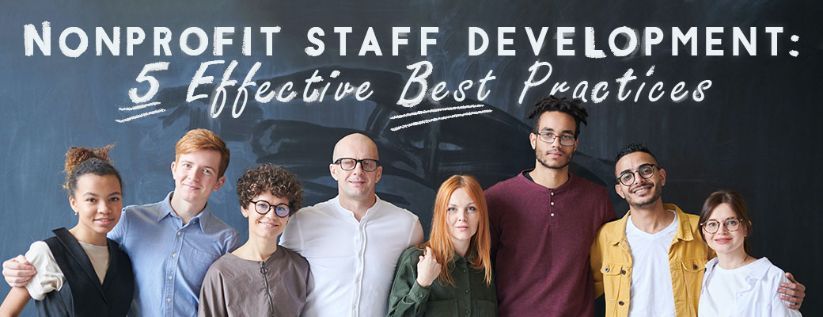Nonprofit Staff Development: 5 Effective Best Practices

Professional development can be complicated, especially within the nonprofit sector. While you’re struggling to meet your budget and serve as many people as you can, even the most experienced staff is falling behind as new techniques and technology burst onto the scene – techniques and technology that could save you money and make mission delivery more effective.
Then there’s the newbies to nonprofits – whether they’re right out of college or transitioning from a business career. These individuals need help ramping up your mission, understanding their role, and how they can make an impact in the nonprofit sector.
So, what can you do to relieve some of the burden of education and training on your stretched budget and precious time? Here are five tips, and a bit more.
- Make it a habit.
- Make it fun.
- Make it short.
- Make it relevant.
- Make it theirs.
Following these tips is a great way to improve your nonprofit staff development practices and bring value to the entire organization. Ready to jump in? Let’s get started.
1. Make it a habit.
Habits are things you just do without thinking, typically based on a trigger and reward. Think about brushing your teeth at night. You just do it. Why? The trigger is that you’re tired. The reward is that it makes your mouth feel fresh and helps you feel ready to sleep.
Make it the same with your nonprofit staff’s learning. I worked with a children’s museum once that gathered everyone in the building in a huge circle in the entry hall at 8 AM daily. They were greeted by a senior staff member, who recognized special occasions, offered a three minute demonstration on some part of the museum, and displayed the newest toy in the gift shop. It was a great habit. The reward? A daily dose of helpful information— and even better, fun!
2. Make it fun.
Speaking of fun! Fun is waaaay too underrated, especially by adults. We have this illusion that “work” (and by extension, learning) can’t be fun to be good. But the reality is that fun is a remarkably effective learning tool – and a lot of nonprofits are great at leveraging fun when it comes to their mission.
Take Scouting. You might think that camping is just fun. But it is so much more. It’s about learning, planning, organizing, and leading – all made fun! But in professional development, we try to hide the fun in learning. Next time you read the word “engaging” in that training brochure— remember— they’re just too embarrassed to say, “it will be fun!”
Fun is hard. It’s easy to be boring and dry when lecturing (which, by the way, is an un-fun way to teach) your staff about charitable bequests (wills) and the signs of someone’s interest in your nonprofit. But believe me (I know, it’s hard), with a little creativity, learning about bequests can be fun. And I’ll tell you this: if it’s boring, your staff will never learn.
3. Make it short.
As a nonprofit leader, you need to get the most from your organization’s time and money. But how? Take learning in short doses.
More and more research shows that when it comes to knowledge absorption, the human brain takes in information almost like pouring water into a funnel. You can pour it in fast, but only so much is getting through the end and into the container. If you pour too much, it backs up and overflows, and that overflow never gets in. To get the most in the quickest time, pour (learn) in small segments.
4. Make it relevant.
Nonprofits are practical. You have a mission to serve and no time to waste. That’s why introducing and applying new information is so important to a nonprofit team. Theory serves as an important framework for all that practical knowledge you want your staff to have. Understanding the theory makes learning practical knowledge more efficient.
After all, isn’t it better if your staff understood germ theory – the fact that microbes cause disease – than to just have them wash their hands all of the time? That way they can apply germ theory to other, practical applications, like cleaning surfaces, wearing masks and staying home when they’re sick.
5. Make it theirs.
Yes, there are particular knowledge sets that each of your staff must have that are specific to their position. Your medical staff needs to know about HIPAA (Health Insurance Portability and Accountability Act). Your accountantneeds to be up to date on this year’s FASB (Financial Accounting Standards Board) standards. But what if you have an accountant who takes an interest in HIPAA, and a nurse is curious about FASB? By all means, let them learn!
People learn much better when they take a personal interest. That doesn’t mean that the accountant isn’t also responsible for learning this year’s new FASB rules, or that the nurse can ignore HIPAA. In fact, by expanding their horizons and learning new skills, they might come up with new and creative ways to apply the information – making your mission more effective!
And one last bonus tip? Don’t be afraid. A lot of professional development is stopped right in its tracks because leadership professionals are afraid – whether of making their staff marketable, of employees meeting other nonprofit leaders who will “steal” them away, or simply wasting time and money.
It turns out that the opposite is true. If someone on your nonprofit staff knows that you are investing in them, they’ll think twice about jumping to a new job (even if the pay is higher). Your dedication to them will be reciprocated by their dedication to you – especially if you take a personal interest in their professional development. And if they do jump, they could be your advocate in the community because you encouraged their career.
So, is nonprofit professional development education and training complicated? It sure can be. Does it have to be? Not nearly as much as you imagine, if you follow these important tips.
About the Author
 Matt Hugg is an author and instructor in nonprofit management in the US and abroad. He is president and founder of Nonprofit.Courses (https://nonprofit.courses), an on-demand, eLearning educational resource for nonprofit leaders, staff, board members and volunteers, with hundreds of courses in nearly every aspect of nonprofit work.
Matt Hugg is an author and instructor in nonprofit management in the US and abroad. He is president and founder of Nonprofit.Courses (https://nonprofit.courses), an on-demand, eLearning educational resource for nonprofit leaders, staff, board members and volunteers, with hundreds of courses in nearly every aspect of nonprofit work.
He’s the author of The Guide to Nonprofit Consulting, and Philanders Family Values, Fun Scenarios for Practical Fundraising Education for Boards, Staff and Volunteers, and a contributing author to The Healthcare Nonprofit: Keys to Effective Management.
Over his 30-year career, Hugg has held positions at the Boy Scouts of America, Lebanon Valley College, the University of Cincinnati, Ursinus College, and the University of the Arts. In these positions, Matt raised thousands of gifts from individuals, foundations, corporations and government entities, and worked with hundreds of volunteers on boards and fundraising committees, in addition to his organizational leadership responsibilities.
Matt teaches fundraising, philanthropy, and marketing in graduate programs at Eastern University, the University of Pennsylvania, Juniata College and Thomas Edison State University via the web, and in-person in the United States, Africa, Asia and Europe, and is a popular conference speaker. He has a BS from Juniata College and an MA in Philanthropy and Development from St. Mary’s University of Minnesota. Mr. Hugg has served on the board of the Greater Philadelphia Chapter of the Association of Fundraising Professionals, the Nonprofit Career Network of Philadelphia and several nonprofits.
